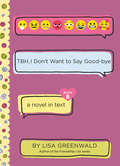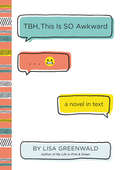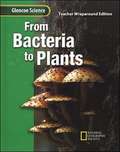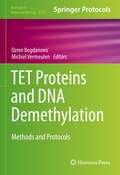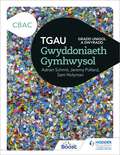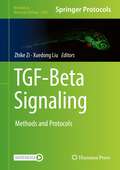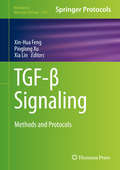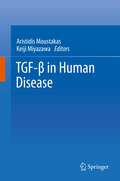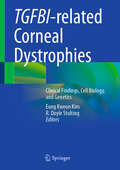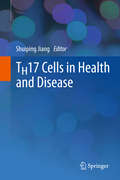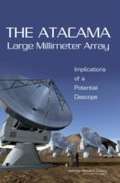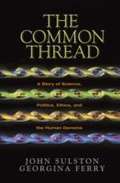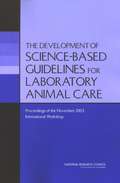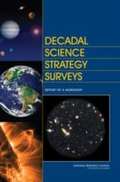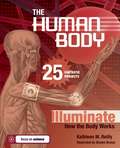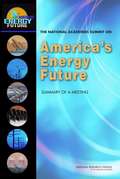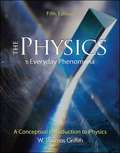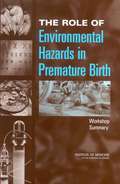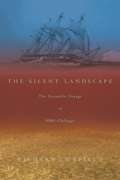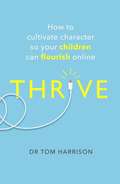- Table View
- List View
TBH #8: TBH, I Don't Want to Say Good-bye (TBH #8)
by Lisa GreenwaldWhen summer break brings BIG changes, these BFFs 4EVA may end up saying good-bye 4EVA in the eighth and final book in this popular middle-grade series told entirely in text messages, emojis, and passed notes. Perfect for fans of Invisible Emmie and the Dork Diaries. TBH, Cece, Prianka, and Gabby thought they’d be together forever. But when Gabby’s mom announces she’s moving to Texas and a backyard BBQ party gets the friends’ blow-out summer off to a rocky start, they end up spending more time apart than together! To be honest, Gabby just wants to get the good-byes over with already. The question is: How can they be BFF 4EVA if everyone goes their separate ways?
TBH, This Is So Awkward (TBH #1)
by Lisa GreenwaldTold entirely in text messages, this addictive new series from the acclaimed author of My Life in Pink & Green is perfect for fans of Lauren Myracle and Wendy Mass. To be honest, middle school is rough! Cecily, Gabby, and Prianka have been BFFAE since pre-K, so it’s totally natural when they don’t include the new girl, Victoria, in their plans and group texts.Between organizing the school Valentine’s Day dance, prepping for their first boy-girl party, and trying to keep their texts so boring their moms won’t use spy apps to read them, the friends only have time for each other.But when Victoria is accidentally sent a hurtful text message, the entire sixth grade gets called out for bullying, cell phones are confiscated, and the trio known as CPG4Eva is forced to figure out just how strong their friendships are IRL.
TEAS 6 Test Prep Flash Cards: Biology Essentials (Exambusters TEAS 6 Workbook #3 of 5)
by Ace Inc.<P><P><i>Advisory: Bookshare has learned that this book offers only partial accessibility. We have kept it in the collection because it is useful for some of our members. Benetech is actively working on projects to improve accessibility issues such as these.</i><P><P> 450 questions and answers. Essential definitions and concepts. <P><P>Topics: Cells, Biochemistry and Energy, Evolution and Classification, Kingdoms: Bacteria, Fungi, Protista; Kingdom: Plantae, Kingdom: Animalia, Human Locomotion, Human Circulation and Immunology, Human Respiration and Excretion, Human Digestion, Human Nervous System, Human Endocrinology, Reproduction and Development, Genetics, Ecology <P>Exambusters TEAS 6 Prep Workbooks provide comprehensive, fundamental TEAS V review--one fact at a time--to prepare students to take practice TEAS V tests. Each TEAS V study guide focuses on one specific subject area covered on the TEAS V exams. From 300 to 600 questions and answers, each volume in the TEAS V series is a quick and easy, focused read. Reviewing TEAS V flash cards is the first step toward more confident TEAS V preparation and ultimately, higher TEAS V exam scores!
TEAS 6 Test Prep Flash Cards: Chemistry Essentials (Exambusters TEAS 6 Workbook #4 of 5)
by Ace Inc.<P><P><i>Advisory: Bookshare has learned that this book offers only partial accessibility. We have kept it in the collection because it is useful for some of our members. Benetech is actively working on projects to improve accessibility issues such as these.</i><P><P> 700 questions and answers. Essential definitions, formulas, concepts, and sample problems. <P><P>Topics: Introduction, Matter, Atoms, Formulas, Moles, Reactions, Elements, Periodic Table, Electrons, Chemical Bonds, Heat, Gases, Phase Changes, Solutions, Reaction Rates, Equilibrium, Acids and Bases, Oxidation and Reduction, Introduction to Organic Chemistry, Radioactivity <P>Exambusters TEAS 6 Prep Workbooks provide comprehensive, fundamental TEAS V review--one fact at a time--to prepare students to take practice TEAS V tests. Each TEAS V study guide focuses on one specific subject area covered on the TEAS V exams. From 300 to 600 questions and answers, each volume in the TEAS V series is a quick and easy, focused read. Reviewing TEAS V flash cards is the first step toward more confident TEAS V preparation and ultimately, higher TEAS V exam scores!
TET Proteins and DNA Demethylation: Methods and Protocols (Methods in Molecular Biology #2272)
by Ozren Bogdanovic Michiel VermeulenThis volume explores the latest methods used to study various aspects of TET proteins and their biology. Chapters in this book are divided into five parts. Part One describes technologies aimed at detecting and quantifying DNA methylation turnover using massively parallel sequencing, ELISA, and mass spectrometry approaches. Part Two looks at data analyses protocols for distinguishing acting versus passive DNA demethylation and estimation of 5mC and 5hmC levels. Part Three deals with a new topic that takes advantage of modified CRISPR/Cas9 genome editing systems to target DNA demethylation activity to genomic loci of interest. Part Four discusses protocols that detail how to purify TET proteins and unravel their protein interactions, and Part Five looks at the assessment of TET protein function and activity in vivo and in vitro. Written in the highly successful Methods in Molecular Biology series format, chapters include introductions to their respective topics, lists of the necessary materials and reagents, step-by-step, readily reproducible laboratory protocols, and tips on troubleshooting and avoiding known pitfalls. Cutting-edge and thorough, TET Proteins and DNA Demethylation: Methods and Protocols is a valuable resource that aims to help research scientists at all levels working in the fields of DNA demethylation dynamics.Chapters 3, 7 and 17 are available open access under a Creative Commons Attribution 4.0 International License via link.springer.com.
TGAU Gwyddoniaeth Gymhwysol CBAC: Single and Double Award
by Jeremy Pollard Adrian Schmit Sam HolymanDevelop students' understanding of Applied Science with engaging content and support throughout the course, produced by a trusted author team and an established WJEC GCSE Science publisher.Students will be able to:- learn what they need to know, with content clearly signposted to support the WJEC GCSE Applied Science Single Award and Double Award qualifications, at both lower and higher tier - approach exams with confidence, by checking their understanding with Test yourself questions, Discussion points, exam-style questions and useful Chapter summaries- build their practical skills with support for all specified practicals along with extra tasks for broader learning- develop the core mathematical skills required by the course with worked examples throughout the book.
TGAU Gwyddoniaeth Gymhwysol CBAC: Single and Double Award
by Jeremy Pollard Adrian Schmit Sam HolymanDevelop students' understanding of Applied Science with engaging content and support throughout the course, produced by a trusted author team and an established WJEC GCSE Science publisher.Students will be able to:- learn what they need to know, with content clearly signposted to support the WJEC GCSE Applied Science Single Award and Double Award qualifications, at both lower and higher tier - approach exams with confidence, by checking their understanding with Test yourself questions, Discussion points, exam-style questions and useful Chapter summaries- build their practical skills with support for all specified practicals along with extra tasks for broader learning- develop the core mathematical skills required by the course with worked examples throughout the book.
TGF-Beta Signaling: Methods and Protocols (Methods in Molecular Biology #2488)
by Xuedong Liu Zhike ZiThis detailed volume is devoted to the recent development of quantitative experiments and computational methods driving new transforming growth factor beta (TGF-β) and other cell signaling knowledge. Many chapters cover quantitative assays for TGF-β signaling studies, with others exploring the increasing role of both modeling and computational methods. Written for the highly successful Methods in Molecular Biology series, chapters include introductions to their respective topics, lists of the necessary materials and reagents, step-by-step, readily reproducible laboratory protocols, and tips on troubleshooting and avoiding known pitfalls. Authoritative and up-to-date, TGF-Beta Signaling: Methods and Protocols serves as a vital resource for researchers seeking to move the TGF-β field into the quantitative realm.
TGF-β Signaling
by Xin-Hua Feng Pinglong Xu Xia LinThis volume details up-to-date information and attempts to take the reader into the exciting realm of TGF-β from the basic principles to the practical applications. Chapters provide basic introduction of TGF-β signaling from the cell surface to the nucleus, methods and techniques for the investigation of TGF-β signaling mechanism including receptors, Smads, intracellular kinases, microRNA, epigenetic regulation, post-translational regulations, non-Smad pathway; the physiological implications including those in cell cycle arrest, epithelial-mesenchymal transition, endothelial cells, adipogenesis, Th differentiation, stem cell, bone remodeling, ovary, zebrofish development, and frog animal capping; and the methodologies including metastasis imaging, 3D morphogenesis, membrane receptor quantification, conditional knockout, bone remodeling, kinase and phosphatase assays, BiFC interaction assays, and genome-wide siRNA screen. Written in the highly successful Methods in Molecular Biology series format, chapters include introductions to their respective topics, lists of the necessary materials and reagents, step-by-step, readily reproducible laboratory protocols, and key tips on troubleshooting and avoiding known pitfalls. Authoritative and practical, TGF-Beta Signaling: Methods and Protocols aims to ensure successful results in the further study of this vital field.
TGF-β in Human Disease
by Aristidis Moustakas Keiji MiyazawaTransforming growth factor-β (TGF-β) is a secreted polypeptide with multifunctional properties manifested during embryonic development, adult organ physiology, and pathobiology of major diseases, including cancer and fibrotic and cardiovascular diseases. The signaling pathway of TGF-β now is rather well understood. Continuing revelations in the mechanisms of action of TGF-β provide specific mechanistic examples of how human cells lose their controlled function and behave wrongly during the development of diverse diseases. Equally important, however, is the current promise of exploiting the TGF-β pathway in combating human disease. This book comprehensively covers major areas of human disease where the involvement of TGF-β is firmly established. Simultaneously, the book highlights major gaps in knowledge and the future directions of research that can benefit human medical science. The core set of diseases where TGF-β action is well documented and are included in the book are cancer and cardiovascular and fibrotic disorders. The central aim of the book is to stimulate young scientists to enter the prolific TGF-β field and find new solutions to the problems remaining in this area of study. For this purpose the book provides authoritative educational chapters that furnish a good introduction to the field for young doctoral students, postdocs, and clinical fellows. The book also serves as a valuable reference for the aficionados in the field, who can find accessible and well-illustrated material for their teaching and lecturing activities, via which the importance of TGF-β biology is disseminated to the world of science and to the public.
TGFBI-related Corneal Dystrophies: Clinical Findings, Cell Biology, and Genetics
by Eung Kweon Kim R. Doyle StultingThis book provides up-to-date information about the basic cell biology, protein processing mechanisms, genetics, and treatment strategies for TGFBI-related corneal dystrophies. Extensive illustrations document the clinical appearance of these dystrophies, and details of their cell biology provide our current understanding of intracellular pathologic mechanisms related to the mutated TGFBI protein. Descriptions of metabolic pathways involving TGFBI protein include recent information about the intracellular processing of normal and mutated TGFBI proteins. Detailed descriptions of the pathologic basis for TGFBI-related corneal dystrophies and possible strategies for human gene therapy are provided. This book offers a rich source of information about the pathogenesis, diagnosis, and treatment options for practicing ophthalmologists, specialists, and trainees.
TH17 Cells in Health and Disease
by Shuiping Jiang"About 25 years ago, Mosmann & Coffman introduced the TH1 / TH2 paradigm of T helper cell differentiation which helped explain many aspects of adaptive immunity from eliminating intracellular versus extracellular pathogens to induction of different types of tissue inflammation. However, TH1 / TH2 paradigm could not adequately explain development of certain inflammatory responses which provided impetus for the discovery of a new subset of T cells called TH17 cells. After the discovery of differentiation and transcription factors for TH17 cells, it was clear that TH17 cells represent an independent subset of T cells with specific functions in eliminating certain extracellular pathogens, presumably not adequately handled by TH1 or TH2 cells. The major role of TH17 cells has been described in inducing auto-immune tissue inflammation. The discovery of TH17 cells has expanded the TH1 / TH2 paradigm, and the integration of TH17 cells with TH1 and TH2 effector T cells is beginning to explain the underlying mechanisms of tissue inflammation in a number of infections and auto-immune disease settings." - From Chapter One by Vijay K. Kuchroo, Harvard University, USA "The recently identified Interleukin 17 (IL-17) cytokine family contributes to immunity to infectious diseases and chronic inflammatory diseases. Further studies on the regulation and function of this important cytokine family may provide better understanding on the roles of the IL-17 family in immune-mediated diseases; such knowledge may lead to the development of immunotherapeutic strategies for treatment of several inflammatory diseases." - From Chapter Two by Chen Dong, University of Texas and MD Anderson Cancer Center, USA
THE ATACAMA Large Millimeter Array: Implications of a Potential Descope
by National Research Council of the National AcademiesThe 1991 NRC decadal survey for astronomy and astrophysics included a project called the Millimeter Array (MMA). This instrument would be an array of millimeter-wavelength telescopes intended to capture images of star-forming regions and distant star-burst galaxies. With the addition of contributions form Europe, the MMA evolved into the Atacama Large Millimeter Array (ALMA), a proposed array of 64, 12-meter antennas. The project is now part of the NSF Major Research Equipment and Facilities budget request. Increased costs, however, have forced the NSF to reconsider the number of antennas. To help with that review, NSF asked the NRC to assess the scientific consequences of reducing the number of active antennas from 60 to either 50 or 40. This report presents an assessment of the effect of downsizing on technical performance specifications, performance degradation, and the ability to perform transformational science, and of the minimum number of antennas needed.
THE COMMON THREAD: A Story of Science, Politics, Ethics, and the Human Genome
by John Sulston Georgina FerryThe world was agog when scientists made the astounding announcement that they had successfully sequenced the human genome. Few contributed so directly to this feat as John Sulston. This is his personal account of one of the largest international scientific operations ever undertaken.It was a momentous occasion when British scientist John Sulston embarked on the greatest scientific endeavor of our times: the sequencing of the Human Genome. In The Common Thread, Sulston takes us behind the scenes for an in-depth look at the controversial story behind the headlines. The accomplishments and the setbacks—along with the politics, personalities, and ethics—that shaped the research are frankly explored by a central figure key to the project.From the beginning, Sulston fervently proclaimed his belief in the free and open exchange of the scientific information that would emerge from the project. Guided by these principles, The Human Genome Project was structured so that all the findings were public, encouraging an unparalleled international collaboration among scientists and researchers.Then, in May 1998, Craig Venter announced that he was quitting the Human Genome Project—with plans to head up a commercial venture launched to bring out the complete sequence three years hence, but marketed in a proprietary database. Venter’s intentions, clearly anathema to Sulston and the global network of scientists working on the Project, marked the beginning of a dramatic struggle to keep the human genome in the public domain.More than the story of human health versus corporate wealth, this is an exploration of the very nature of a scientific quest for discovery. Infused with Sulston’s own enthusiasm and excitement, the tale unfolds to reveal the scientists who painstakingly turn the key that will unlock the riddle of the human genome. We are privy to the joy and exuberance of success as well as the stark disappointments posed by inevitable failures. It is truly a wild and wonderful ride.The Common Thread is at once a compelling history and an impassioned call for ethical responsibility in scientific research. As the boundaries between science and big business increasingly blur, and researchers race to patent medical discoveries, the international community needs to find a common protocol for the protection of the wider human interest. This extraordinary enterprise is a glimpse of our shared human heritage, offering hope for future research and a fresh outlook on our understanding of ourselves.
THE DEVELOPMENT OF SCIENCE-BASED GUIDELINES FOR LABORATORY ANIMAL CARE: Proceedings of the November 2003 International Workshop
by Institute for Laboratory Animal ResearchInformation into THE DEVELOPMENT OF SCIENCE-BASED GUIDELINES FOR LABORATORY ANIMAL CARE
THE FUTURE OF U.S. Chemistry Research: BENCHMARKS AND CHALLENGES
by National Research Council of the National AcademiesChemistry plays a key role in conquering diseases, solving energy problems, addressing environmental problems, providing the discoveries that lead to new industries, and developing new materials and technologies for national defense and homeland security. However, the field is currently facing a crucial time of change and is struggling to position itself to meet the needs of the future as it expands beyond its traditional core toward areas related to biology, materials science, and nanotechnology. At the request of the National Science Foundation and the U.S. Department of Energy, the National Research Council conducted an in-depth benchmarking analysis to gauge the current standing of the U.S. chemistry field in the world. The Future of U.S. Chemistry Research: Benchmarks and Challenges highlights the main findings of the benchmarking exercise.
THE HUMAN BODY
by Shawn Braley Kathleen M. ReillyKids will be amazed at all the action that's going on right inside their own bodies, from understanding just how that apple turns into energy to how the "leftovers" make their exit. The Human Body: 25 Fantastic Projects Illuminate How the Body Works will engage kids with hands-on activities that will show them all the fantastic, well-orchestrated systems at work in their very own bodies-they'll see exactly how smoke affects the lung, how the heart really acts as a liquid pump, and how the different joints are structured and serve different purposes. Kids will gain a concrete understanding of their bodies-and realize in the process just how amazing they really are.
THE LANGUAGE OF LIFE: How Cells Communicate in Health and Disease
by Debra NiehoffCooperation requires conversation. Human beings speak to one another. Sounds, scents, and postures allow animals to make their point. While individual cells can't talk, hiss, growl, or bare their teeth, they nevertheless communicate regularly. Their language is based not on words or gestures, but on chemistry--using molecules where we would use words, constructing sentences from chains of proteins. The cells that make up the bodies of muticellular organisms inform, wheedle, command, exhort, reassure, nurture, criticize, and instruct each other to direct every physiological function, report every newsworthy event, record every memory, heal every wound. And each of those chemical conversations represents an opportunity for scientists and physicians. The molecular biologists who worked for over a decade to sequence the human genome have sometimes referred to that sequence as the "book of life. " To our cells, that "book" is no more than a dictionary--only living cells can converse, forming the network that allows our 60 trillion cells to function as a single organism. For nearly a century, researchers have been straining to hear the whispered conversations among cells, hoping to master the basics of their language. They know that if we can decipher and translate this cellular chatter, we have the potential for sending signals of our own that could repair wounds, reduce cholesterol, control insulin levels, or even block the reproduction of cancer cells. The possibilities are as endless as they are intriguing. The Language of Life is a fantastic story of discovery, blending the vision of science with the poetry of life itself.
THE NATIONAL ACADEMIES SUMMIT ON America's Energy Future: SUMMARY OF A MEETING
by National Research Council of the National AcademiesThere is a growing sense of national urgency about the role of energy in long-term U.S. economic vitality, national security, and climate change. This urgency is the consequence of many factors, including the rising global demand for energy; the need for long-term security of energy supplies, especially oil; growing global concerns about carbon dioxide emissions; and many other factors affected to a great degree by government policies both here and abroad. On March 13, 2008, the National Academies brought together many of the most knowledgeable and influential people working on energy issues today to discuss how we can meet the need for energy without irreparably damaging Earth's environment or compromising U.S. economic and national security-a complex problem that will require technological and social changes that have few parallels in human history. The National Academies Summit on America's Energy Future: Summary of a Meeting chronicles that 2-day summit and serves as a current and far-reaching foundation for examining energy policy. The summit is part of the ongoing project 'America's Energy Future: Technology Opportunities, Risks, and Tradeoffs,' which will produce a series of reports providing authoritative estimates and analysis of the current and future supply of and demand for energy; new and existing technologies to meet those demands; their associated impacts; and their projected costs. The National Academies Summit on America's Energy Future: Summary of a Meeting is an essential base for anyone with an interest in strategic, tactical, and policy issues. Federal and state policy makers will find this book invaluable, as will industry leaders, investors, and others willing to convert concern into action to solve the energy problem.
THE ROLE OF Environmental Hazards in Premature Birth: Workshop Summary
by Medicine Research Roundtable on Environmental Health SciencesEach year in the United States approximately 440,000 babies are born premature. These infants are at greater risk of death, and are more likely to suffer lifelong medical complications than full-term infants. Clinicians and researchers have made vast improvements in treating preterm birth; however, little success has been attained in understanding and preventing preterm birth. Understanding the complexity of interactions underlying preterm birth will be needed if further gains in outcomes are expected. The Institute of Medicine’s Roundtable on Environmental Health Sciences, Research, and Medicine sponsored a workshop to understand the biological mechanism of normal labor and delivery, and how environmental influences, as broadly defined, can interact with the processes of normal pregnancy to result in preterm birth. This report is a summary of the main themes presented by the speakers and participants.
THE ROLE OF THEORY IN ADVANCING 21ST-CENTURY BIOLOGY: Catalyzing Transformative Research
by National Research Council of the National AcademiesAlthough its importance is not always recognized, theory is an integral part of all biological research. Biologists' theoretical and conceptual frameworks inform every step of their research, affecting what experiments they do, what techniques and technologies they develop and use, and how they interpret their data. By examining how theory can help biologists answer questions like "What are the engineering principles of life?" or "How do cells really work?" the report shows how theory synthesizes biological knowledge from the molecular level to the level of whole ecosystems. The book concludes that theory is already an inextricable thread running throughout the practice of biology; but that explicitly giving theory equal status with other components of biological research could help catalyze transformative research that will lead to creative, dynamic, and innovative advances in our understanding of life.
THE SILENT LANDSCAPE: The Scientific Voyage of HMS Challenger
by Richard CorfieldIn 1872 HMS Challenger set sail from Portsmouth, England, to map and sample the ocean floor. This marked the birth of modern oceanography. By retracing Challenger’s extraordinary voyage, we view our underwater landscape anew – focusing on what 21st century science is now able to add to this incredible story. The oceans make up more than two thirds of the Earth’s surface. But they are as mysterious for what they conceal beneath their surfaces as they are familiar for their ubiquity. Deep below the susurrus swell of waves lies an alien world that we have only begun to explore. The quest to know more about this secret domain began in earnest in the late 1800s. In 1859, Charles Darwin’s book On the Origin of Species by Means of Natural Selection set the scientific world abuzz with its radical theory of evolution, and sparked a feverish desire to know more about the workings of nature. Scientists became increasingly convinced that the ocean floor could provide proof – or refutation – of Darwin’s theory of natural selection. They believed that the ocean floor was a haven for life that had long been extinct on land and that obscure fossil evidence culled from the depths could provide us with information on species that no longer existed topside. So an expedition was specifically designed and undertaken to investigate the natural history and geology of the ocean floor. With its emphasis on locating and retrieving fossil records that would test the new theory of evolution, Challenger’s voyage was nothing less than a mission to choose between God and science. Sailing three and half years and 69,000 nautical miles through burning tropical heat waves and stupefyingly cold Antarctic seas, and suffering further privations of hunger, storms, and sometimes crushing boredom between data-collecting surveys, Challenger dredged up thousands of samples from the sea floor and mapped enormous areas of undersea terrain. The final result was nothing short of a roaring success. So extensive were their findings that it was to take the scientists 19 years to completely examine and report on all their data. The final report, published in 1895, ran to fifty volumes. Most startling of all was the revelation that the ocean was not a silent landscape that serenely reflected Earth’s past – it was a gloriously vibrant ecosystem teeming with a variety and multitude of life on a scale we could scarcely imagine from our landlocked perspective. Relying on the official documentation, logs, and journals of the ship’s company, The Silent Landscape recounts the tale of an extraordinary voyage brought to life by 21st-century science. From the endangered coral reefs of the Caribbean to the trackless depths beneath the western Pacific, The Silent Landscape takes us on an epic journey across time.
THRIVE: How to Cultivate Character So Your Children Can Flourish Online
by Dr Tom HarrisonWinner of the International Federation for Family Development Award.When Dr Tom Harrison, a leading expert in the field of character education and the Internet, bought his daughter her first smartphone, a major milestone had been reached: she had entered the 'cyber-world'. Harrison no longer needed to know what to think; he needed to know what to do. This is the first practical book of its kind to show parents and teachers how to develop character as the foundation for helping young people to thrive in their online interactions. It answers the question: How do we prepare our children to do the right thing when no one is watching?Based on his own experience as a parent, more than a decade of research and thousands of conversations with parents, teachers, children and policymakers, the REACT and THRIVE models have been developed to engage with character, wellbeing, social and emotional learning, ethics and digital citizenship - all the ingredients for flourishing online.The world is waking up to the importance of character for individual and wider societal flourishing. Harrison is at the forefront of this movement and is regularly invited to advise policymakers and thousand of teachers and parents around the world. This book is a must-read for parents and educators who want to help children not just survive but thrive online in their cyber-worlds.
